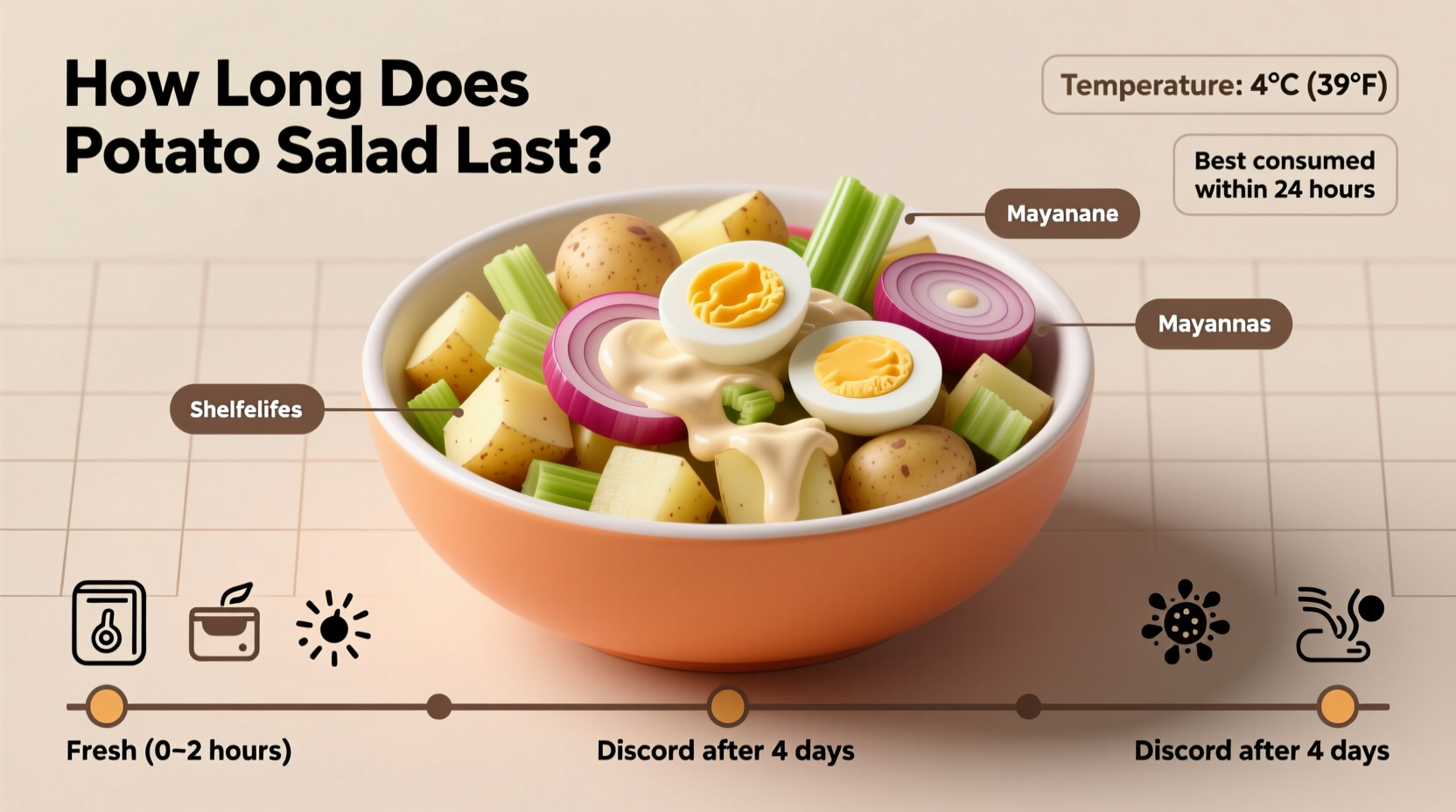Homemade potato salad lasts 3-5 days in the refrigerator when stored properly in an airtight container at or below 40°F (4°C). Store-bought varieties with preservatives may last up to 7 days. Never leave potato salad at room temperature for more than 2 hours (1 hour if above 90°F/32°C).
Ever made a big batch of potato salad for a summer gathering only to wonder if it's still safe to eat the next day? You're not alone. With its creamy dressing and cooked potatoes, potato salad sits in a food safety gray zone that causes confusion for many home cooks. Getting this wrong isn't just about unpleasant flavors—spoiled potato salad can lead to foodborne illness. Let's cut through the confusion with science-backed storage guidelines you can trust.
Why Potato Salad Spoilage Matters More Than You Think
Potato salad occupies what food safety experts call the "temperature danger zone" – the range between 40°F and 140°F where bacteria multiply rapidly. The combination of cooked potatoes (which provide moisture and nutrients), mayonnaise-based dressing, and often dairy or egg ingredients creates an ideal breeding ground for pathogens like Staphylococcus aureus and Salmonella.
According to the USDA Food Safety and Inspection Service, potato salad represents one of the top picnic food safety concerns due to its perishable ingredients and frequent exposure to fluctuating temperatures during outdoor events. Unlike some foods where spoilage is obvious, contaminated potato salad may look and smell normal while still harboring dangerous bacteria.
Your Complete Potato Salad Storage Timeline
Understanding exactly how long your potato salad remains safe requires considering multiple factors. Here's what food safety research tells us about different storage scenarios:
| Storage Condition | Maximum Safe Duration | Critical Notes |
|---|---|---|
| Refrigerator (40°F or below) | 3-5 days (homemade) 5-7 days (store-bought) |
Store in airtight container; place in coldest part of fridge |
| Room Temperature | 2 hours max (1 hour if above 90°F) |
Discard immediately after exceeding time limit |
| Insulated Cooler with Ice Packs | 4-6 hours | Check temperature hourly; replace ice packs as needed |
| Freezer (0°F or below) | 1-2 months | Texture changes significantly upon thawing; best for cooked potatoes only |
Spotting Spoiled Potato Salad: Beyond the Obvious Signs
While visible mold is an obvious red flag, dangerous bacteria often don't produce visible changes. Here's what to check before serving leftovers:
- Smell test: Sour or acidic odor (distinct from vinegar in the recipe)
- Texture changes: Slimy consistency or excessive liquid separation
- Visual inspection: Discoloration beyond normal browning of cut potatoes
- Taste test (last resort): If other signs are ambiguous, take a tiny taste – spit out immediately if sour or off
When in doubt, throw it out. The USDA emphasizes that "when foods are in doubt, they should be discarded" – a small price to pay compared to potential foodborne illness.
Maximizing Freshness: Proven Storage Techniques
Professional kitchens follow these evidence-based practices to extend potato salad's shelf life while maintaining safety:
- Cool potatoes properly: Spread cooked potatoes in a single layer to cool within 2 hours before mixing with dressing
- Use clean containers: Glass or BPA-free plastic containers with tight-sealing lids prevent contamination
- Temperature monitoring: Keep refrigerator at 37-38°F (not the default 40°F setting) for optimal food safety
- Portion control: Divide large batches into smaller containers to minimize repeated temperature exposure
- Label everything: Note preparation date on container with masking tape and marker
According to research from the National Center for Home Food Preservation, these techniques can help maintain potato salad quality while staying within safe consumption windows. The key is minimizing the time the salad spends in the temperature danger zone during preparation and storage.

Homemade vs. Store-Bought: Understanding the Differences
Many assume store-bought potato salad lasts longer due to preservatives, but the reality is more nuanced:
- Homemade versions: Typically contain fresh ingredients without stabilizers, making them more perishable but often tastier
- Commercial products: May contain calcium disodium EDTA or other preservatives that extend shelf life but can affect texture
- Restaurant-prepared: Often made with higher acid dressings that naturally inhibit bacterial growth
The FDA Food Code specifies that ready-to-eat potentially hazardous foods like potato salad must be labeled with preparation time and discarded after 7 days. However, most food safety experts recommend following the shorter 3-5 day guideline for optimal safety, especially for homemade versions.
Situation-Specific Guidance: When Rules Change
Certain scenarios require special consideration beyond standard storage guidelines:
- Picnics and outdoor events: Keep potato salad in a cooler with ice packs until serving; never leave uncovered in direct sunlight
- Leftovers from restaurants: Consume within 3 days regardless of "use by" date due to unknown preparation conditions
- Vacation scenarios: If leaving home, discard all perishables before departure – don't risk returning to spoiled food
- Power outages: Discard potato salad if refrigerator temperature exceeded 40°F for more than 2 hours
Food safety researchers at Cornell University note that "the two-hour rule" becomes particularly critical during summer months when ambient temperatures accelerate bacterial growth. Their studies show that potato salad left at 90°F can reach dangerous bacterial levels in as little as 60 minutes.
Food Safety Myths That Could Make You Sick
Several common misconceptions about potato salad safety persist despite evidence to the contrary:
- Myth: The vinegar in potato salad prevents spoilage
- Reality: While acid helps, it doesn't eliminate bacterial growth risks
- Myth: If it smells fine, it's safe to eat
- Reality: Pathogenic bacteria often don't produce noticeable odors
- Myth: Freezing destroys all bacteria
- Reality: Freezing only pauses bacterial growth; pathogens reactivate upon thawing
The Partnership for Food Safety Education emphasizes that "when it comes to food safety, your senses aren't always reliable" – which is why following time and temperature guidelines matters more than subjective assessments.
When to Toss: Clear Indicators of Unsafe Potato Salad
Don't risk foodborne illness by ignoring these definitive spoilage signs:
- Visible mold of any color (not just the typical green or white)
- Unpleasant sour or ammonia-like odors
- Slippery or slimy texture on potatoes or dressing
- Excessive liquid separation that doesn't reincorporate when stirred
- Unusual bubbling or fizzing when stirred
Remember that "a little mold" isn't safe to cut off in potato salad as you might with hard cheese. The University of Minnesota Extension explains that in moist foods like potato salad, mold roots can extend far beyond visible spots, making the entire batch unsafe.
Practical Food Safety: Making It Work in Real Life
Implement these actionable strategies for safer potato salad enjoyment:
- Prepare potato salad the day of your event rather than days in advance
- Use a food thermometer to verify refrigerator temperature weekly
- Keep a dedicated cooler just for potato salad and other perishables at outdoor events
- When in doubt about storage time, write the discard date directly on the container
- Consider making smaller batches more frequently rather than one large batch
Food safety isn't about perfection – it's about smart risk management. By understanding the science behind potato salad spoilage and implementing these practical strategies, you can enjoy this classic dish with confidence all summer long.
Can I eat potato salad after 7 days in the refrigerator?
No, potato salad should not be consumed after 5 days in the refrigerator, even if it appears fine. The USDA recommends discarding homemade potato salad after 3-5 days due to rapid bacterial growth in the temperature danger zone. Store-bought versions with preservatives may last up to 7 days, but 5 days remains the safer guideline.
What happens if I eat spoiled potato salad?
Consuming spoiled potato salad can cause foodborne illness with symptoms including nausea, vomiting, diarrhea, abdominal cramps, and fever. Symptoms typically appear 6-24 hours after consumption and can last 1-3 days. In severe cases, especially for vulnerable populations, medical attention may be required.
Does adding extra vinegar extend potato salad's shelf life?
While vinegar creates a more acidic environment that slows some bacterial growth, it doesn't significantly extend potato salad's safe storage time. The USDA maintains that even vinegar-based potato salads should be consumed within 3-5 days when refrigerated. Proper temperature control remains more critical than acidity levels for food safety.
Can I freeze potato salad to make it last longer?
Freezing potato salad is not recommended for quality reasons, though it's technically safe. The mayonnaise-based dressing will separate and potatoes become waterlogged and mushy upon thawing. If absolutely necessary, freeze just the cooked potatoes for up to 2 months, then make fresh dressing when ready to serve. The texture will be compromised but safer than risking foodborne illness from spoiled salad.
How can I tell if potato salad is still good if I forgot the preparation date?
If you've lost track of when potato salad was made, perform a thorough safety check: smell for sour or acidic odors (beyond normal vinegar), check for slimy texture, look for mold or unusual discoloration. When in doubt, discard it. The USDA Food Safety and Inspection Service states: "When in doubt, throw it out" – a small price to pay compared to potential foodborne illness.











 浙公网安备
33010002000092号
浙公网安备
33010002000092号 浙B2-20120091-4
浙B2-20120091-4